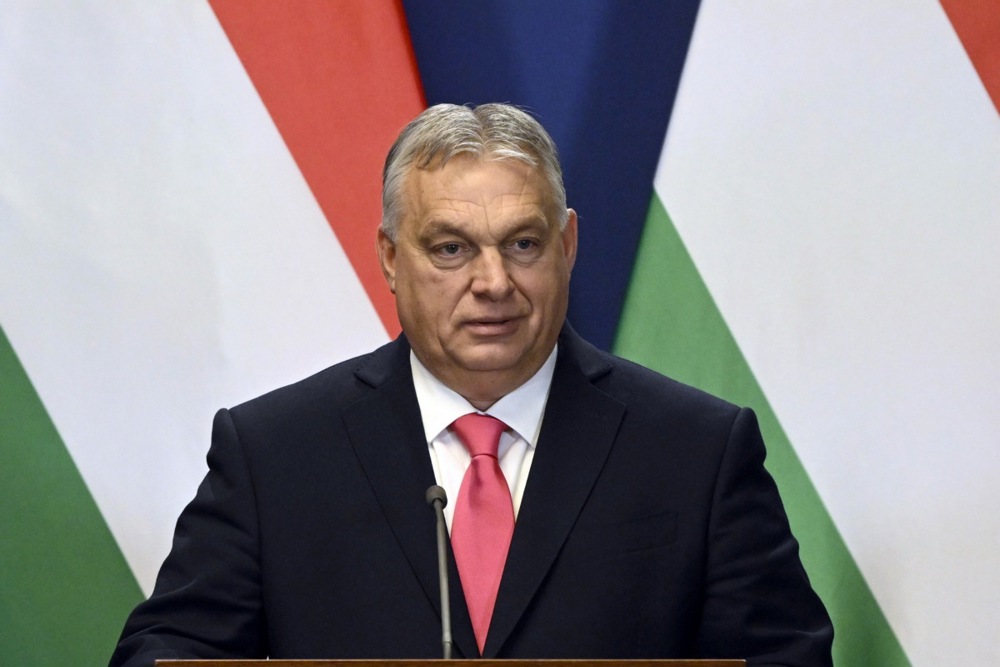We have been travelling in this direction for many years. First there was Obama’s pivot to the Pacific, an early reaction to China’s rise; but in 2014 Crimea happened and the US pivoted back to Europe. Then came the Trump scare of 2017-18, but the Allies started paying up and in the US the “Russia hoax” kept the president’s NATO policy in check – in fact, it even strengthened it. The Trump administration’s key strategic move, however, was to reorient and focus the US national security apparatus on China as the primary threat, and to forge a bipartisan consensus in American politics on this issue – the only one on which both the Republicans and the Democrats agree. This time the “pivot” is here to stay.
When Biden took office Europe drew a sigh of relief: the “grown-ups” were supposedly back in charge. But the Afghan debacle followed, then the failure to deter Putin from invading Ukraine again. It was Britain – not the US – which steadied Western nerves in the critical first few days of the war, and has since strengthened the allied response at every turn, from providing the first Western tanks to the first cruise missiles and so on.
US military support for Ukraine has been the largest overall, and indispensable particularly in the battles of 2022. But the Biden administration has often been dragging its feet, sending too little (compared to its capacity) too late – to the point where its policy hit the Congressional rocks where it lies lifeless for now. All this has been happening against the background of a sudden multi-pronged security emergency in the Middle East and a deteriorating military balance with China in the Western Pacific.
It is important to bear this history of the past 10 to 15 years in mind as we brace for impact with the systemic shocks coming our way as a result of our own policy failures. The fundamental geopolitical trend of this period has been the gradual shift in the global balance of power as America’s relative position to China, in economic and military terms, has been declining. This move away from America’s “unipolar moment” of post-Cold War global hegemony need not have led to a crisis; the West’s current predicament was never pre-determined.
Early strategic action based on a much stronger military posture could have been undertaken with more vigour – but at greater political and financial cost – to keep revisionist powers at bay, from Russia to China. The alternative, i.e. the late mobilisation against China and the lax and overly-friendly indulgence of European security free-riding, was always going to end up in “tears” – as we are seeing now from Europe to Asia, and especially in Ukraine.
In particular the collective West has wasted the critical past five-seven years – arguably the last window of opportunity to turn things around – without decisive action to prepare for a serious military confrontation despite all the signs pointing in that direction. One of the clearest alarm bells was sounded in 2017 by the Center for Strategic and Budgetary Assessments, which groups some of America’s best strategic minds. Its flagship strategic assessment that year also concluded that “the U.S. should shift to a forward defense posture in the Western Pacific Theater of Operations, even at the expense of the European and Middle East Theaters”.
All the indicators underlying CSBA’s report in 2017 – such as China’s GDP standing at around 60 per cent of the US GDP in 2014, already higher than the maximum of 40 per cent achieved by the Soviets in 1980 or the 13.5 per cent that Japan had in 1943 at its height – have worsened in the meantime. The Chinese/US GDP ratio is now 73 per cent, and the Chinese navy already surpassed the American one in numbers back in 2021, widening the gap ever since. Calculations of overall military balances are much more complex than this, of course, but the general point is that China has simply grown so powerful in the international system that the US must now devote many more resources to this threat than before – from not a much bigger US force pool and arsenal than five or ten years ago.
This dynamic has become inevitable and its stark realities have now filtered through not just the US political establishment but even through the ranks of the most starry-eyed fools populating Europe’s corridors of power. Suddenly they have realised that the loosening of America’s security ties to Europe in the coming years or sooner is not (just) a Trump risk but has become a US strategic imperative in its own right, irrespective of who sits in the White House. Perhaps there would be a difference in the style and speed – and to a certain extent scale, in certain areas – of the US drawdown under a Democrat president versus a Republican one, but the traditional NATO arrangements for Europe in their fundamental US-centred paradigm are untenable in the long run.
There is already talk of a potential “European alternative to NATO”, and the EU is now expected to create a new high-level post of Defence Commissioner. At a meeting last week, Polish prime minister Tusk suggested to the German chancellor that the EU must become a “serious military power”, while the French foreign minister spoke of a “European pillar” of NATO “in addition” to the alliance.
Much of this kind of talk about a “European defence” gives a sense of déjà vu: the EU also used past crisis points like Brexit or the first Trump presidency to push for greater integration in the security field; this agenda is certainly at play now as well. But the present moment is different because everyone can see there are real – indeed, existential – dangers threatening the continent this time around.
The coordinated and unprecedented warnings in this regard from some of Europe’s highest-ranking military figures, and their insistence on drastic military build-up measures, is striking. And as detailed in these pages recently, there is now a genuine panic at the political level while the expansion of defence-industrial capacity is gathering pace, albeit from a low bar. None of this would happen if the European elites were not beginning to have serious concerns about US support over the long term as a matter of strategic, not party-political, reality.
But what are the implications of a “security break” or “divorce” between the US and Europe? To be clear, by this we should understand a situation where significant US forces and assets are eventually withdrawn from the European theatre, and America’s commitment to NATO and Article 5 becomes unreliable politically (which could happen before the bulk of US forces leave the continent). NATO would likely continue to exist but only as a hollowed-out coordination framework.
For Europe, this sort of future would raise very practical questions of defence against the Russian threat, particularly through the loss of the bulk of some key capabilities now provided chiefly by the US. These include: air-to-air-refuelling; intelligence; surveillance; target acquisition and reconnaissance (ISTAR) assets including specialised aircraft; high-altitude drones; satellites; strategic bombers and stealth aviation; electronic warfare; missile defence; cruise missiles; cyber – and the list goes on.
The expansion of ammunition and (some classes of) military equipment production, for example by Rheinmetall, as well as the planned expansion of force structures in places like Poland, are welcome developments. But, as things stand, these current plans are barely designed to bring European militaries back up to a standard and warfighting capability where they can face off the Russians with American support as presently assured. Without the US element, current European rearmament efforts will be revealed to be grossly insufficient even if successful on their own terms over the next 3 to 5 years that may separate us from a direct confrontation with Russia.
Another consequence of an American break with Europe would be the removal of the US component from command and control systems in allied strategic headquarters or other operational field commands, which would also have incalculable effects in any actual European warfighting scenarios. Over 75 years of NATO experience the idea that the US will be there to provide the top politico-military leadership and authority in case of war has become deeply ingrained in the European defence “mind”. The prospect of the Europeans having to negotiate among themselves their own command arrangements – who should be “in charge” – for a functional “European NATO” is more daunting than commonly assumed.
Towering above all these issues is that of nuclear deterrence: what will or even can replace the US atomic umbrella which will inevitably also be withdrawn – or rather, lose its credibility – if America ties to Europe loosen? There is already renewed debate on this question, including through an intervention last week from Germany’s finance minister who suggested a “rethink” of Europe’s nuclear arrangements.
Only the UK and France possess nuclear weapons this side of the Atlantic, with a host of limitations in terms of numbers, types and means of delivery, compared to what the US has. For example it is unclear if they can compensate the loss of the US arsenal from Europe’s strategic stability equation with Russia even just in terms of overall numbers to begin with.
The nuclear question is incredibly thorny from a command perspective if the US element in NATO is weakened or disappears. This would certainly make Britain wary of placing its nukes under some non-NATO “European” multilateral command arrangement, or a NATO without the US firmly in the lead. France is even more reluctant to acquiesce to the former, for traditional reasons, or would seek to exact a higher price in terms of its own role in Europe’s overall future defence structures than Germany and others could accept.
Again, given Europe’s record of internal debate and dysfunction even on much less vital subjects, it is virtually impossible to envisage a pathway to agreement over a purely-European nuclear deterrent, in any kind of reasonable timeframe. Yet until this question is settled, any serious question of “European defence” in an actual war with nuclear-armed Russia is moot: the strategic imbalance and Moscow’s nuclear escalation potential would be unanswerable.
The list can go on, but even the considerations outlined so far suffice to show that, in practical terms, when all is said and done, the notion of a European defence entirely without the US, in the short run, is very difficult to conceive. Material challenges aside, the prospects for Europe constructing a coherent and credible joint force alone are especially uncertain from a political perspective, particularly in conditions of severe Russian hybrid warfare pressure.
But a sudden and complete US “exit” from Europe is the more extreme scenario, even though the transatlantic security relationship looks ever more certain to weaken and eventually break, to all intents and purposes, in the longer term. The more likely scenario – which should focus minds in Europe – is that of an increasingly messy and chaotic next decade or so, with US policy increasingly dysfunctional and unreliable and the Europeans not quite rising to this unprecedented challenge. Threading a secure policy path through this upcoming period would test even the most astute statesmen – if we even had them.
There is now decreasing value in laying out “best case scenarios” for strategic policy at a time of collapsing world order. The ideal will not happen: we have lost some of the last chances to stabilise the system and shape events over the past few years through strong policy interventions and leadership. Europe is particularly vulnerable. But it has been here before, and survived, even if at great cost.
Gabriel Elefteriu is deputy director at the Council on Geostrategy in London and a fellow at the Yorktown Institute in Washington, D.C.






Europe’s capital needs media to challenge the status quo: That’s why Brussels Signal is launching